From Tomb to Altar
At first, Christians followed the same burial practices as other ancient peoples: they buried their dead, bodies intact. But soon they began to exhume certain bodies and rebury them in locations deemed more appropriate by the communities to which they had belonged. In some instances, they even divided up these bodies, distributing their components parts to those who laid claim over them.
Read more »
While scholars have been unable to account for all aspects of this change, it is clear that only extraordinary bodies received such treatment. This was the case with Polycarp, bishop of Smyrna, who died for his faith around 156 CE. His followers reportedly considered his bones to be "more valuable than precious stones and finer than refined gold." The veneration of Polycarp's remains soon became so intense that the authorities had to burn his bones, in order to prevent them from gaining any future power.
This power stemmed from the belief that the bodies of the saints had a special bond to Christ, evidenced by the incorruptibility of their flesh. When Ambrose, Bishop of Milan, unearthed the bodies of Saints Gervasius and Protasius in the Basilica of Saints Felix and Nabor in 385/6, he marveled at their state of perfection. He then had them translated to the newly completed Basilica Ambrosiana, where he placed them under the altar, both for safekeeping and as a means of consecrating the space.
By the ninth and tenth centuries, relics had become an integral feature of the Christian altar. In fact, relics were essential to the dedication of each new altar, making the dismemberment of the saintly body an increasingly common occurrence. Although some theologians worried what this would mean at the Last Judgment, others argued that dismemberment would have no bearing on the fate of the immortal body.
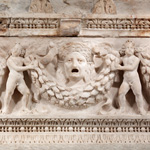 Garland Sarcophagus
This sarcophagus, festooned with carved garlands, was likely made in Phrygia, a region of present-day Turkey, and then shipped to Rome, where it was used in the tomb of a wealthy Roman family.
Garland Sarcophagus
This sarcophagus, festooned with carved garlands, was likely made in Phrygia, a region of present-day Turkey, and then shipped to Rome, where it was used in the tomb of a wealthy Roman family.
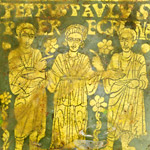 Gold Glass with Sts. Peter and Paul and Peregrina
The two men surely represent Sts. Peter and Paul, who are often paired in Christian imagery, are honored on the same feast day, and are commonly depicted on surviving gold glasses.
Gold Glass with Sts. Peter and Paul and Peregrina
The two men surely represent Sts. Peter and Paul, who are often paired in Christian imagery, are honored on the same feast day, and are commonly depicted on surviving gold glasses.
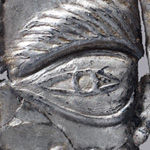 Votive Plaque with Eyes
Pilgrims could take home tokens from the shrines they had visited, but they could also purchase small votive offerings to be left at the shrines, prolonging their spiritual devotion long after they had left.
Votive Plaque with Eyes
Pilgrims could take home tokens from the shrines they had visited, but they could also purchase small votive offerings to be left at the shrines, prolonging their spiritual devotion long after they had left.
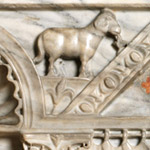 Front Panel of a Box-Shaped Altar
This large relief panel was long considered to be the front of an early Byzantine sarcophagus, sliced off and reused as an altar frontal in the Church of San Carlino in Ravenna in the later Middle Ages.
Front Panel of a Box-Shaped Altar
This large relief panel was long considered to be the front of an early Byzantine sarcophagus, sliced off and reused as an altar frontal in the Church of San Carlino in Ravenna in the later Middle Ages.
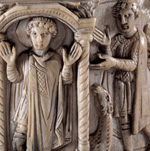 Pyxis
Pyxides—lidded, circular boxes made to store medicines or cosmetics—were also used as reliquaries.
Pyxis
Pyxides—lidded, circular boxes made to store medicines or cosmetics—were also used as reliquaries.
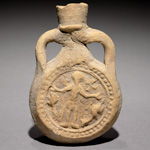 Pilgrim Flask of St. Menas
The widespread popularity of the cult of St. Menas is attested by the hundreds of pilgrim flasks from his shrine that have been found throughout the Mediterranean region.
Pilgrim Flask of St. Menas
The widespread popularity of the cult of St. Menas is attested by the hundreds of pilgrim flasks from his shrine that have been found throughout the Mediterranean region.
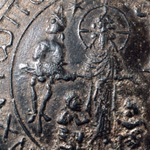 Pilgrim Flask
Christian pilgrims to the Holy Land not only desired to touch and kiss objects associated with Christ's Passion; they also sought to preserve and carry home with them substances that could claim some physical contact or proximity to the sites and objects they had seen and venerated.
Pilgrim Flask
Christian pilgrims to the Holy Land not only desired to touch and kiss objects associated with Christ's Passion; they also sought to preserve and carry home with them substances that could claim some physical contact or proximity to the sites and objects they had seen and venerated.
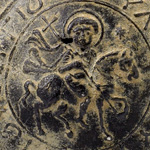 Pilgrim Flask of St. Sergios
These small vials were made to contain holy water or holy oil from a saint's shrine and were usually made of relatively cheap materials and were cast in reusable molds.
Pilgrim Flask of St. Sergios
These small vials were made to contain holy water or holy oil from a saint's shrine and were usually made of relatively cheap materials and were cast in reusable molds.
 Necklace with Pendants
In the Christianized Roman Empire, necklaces with cross pendants and amuletic capsules functioned as objects of personal adornment and symbols of social status as well as powerful protective devices.
Necklace with Pendants
In the Christianized Roman Empire, necklaces with cross pendants and amuletic capsules functioned as objects of personal adornment and symbols of social status as well as powerful protective devices.
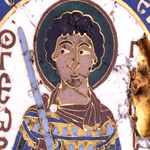 Reliquary Pendant of St. Demetrios with St. George
The relics of Demetrios were not his bones, but oil or myron collected from his tomb and blood-soaked earth taken from the site of his martyrdom.
Reliquary Pendant of St. Demetrios with St. George
The relics of Demetrios were not his bones, but oil or myron collected from his tomb and blood-soaked earth taken from the site of his martyrdom.
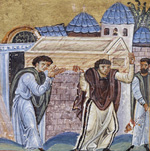 Menologion with Scenes of Martyrdom
A menologion (from the Greek word for month) is a catalogue of saints arranged in order of their feast days.
Menologion with Scenes of Martyrdom
A menologion (from the Greek word for month) is a catalogue of saints arranged in order of their feast days.
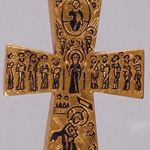 Pectoral Reliquary Cross
At a depth close to the original street level in the Bulgarian capital of Pliska, archaeologists unearthed this tiny object that would have been treasured because of a miniscule piece of wood inside.
Pectoral Reliquary Cross
At a depth close to the original street level in the Bulgarian capital of Pliska, archaeologists unearthed this tiny object that would have been treasured because of a miniscule piece of wood inside.
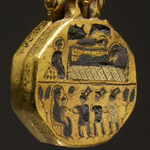 Reliquary Pendant with the Adoration of the Magi
This locket could have been worn or held and contains a cavity, closed by a sliding pin, that probably held relics.
Reliquary Pendant with the Adoration of the Magi
This locket could have been worn or held and contains a cavity, closed by a sliding pin, that probably held relics.
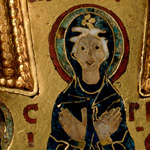 Pendant Reliquary Cross
This reliquary cross, which preserves its original chain, is made of gold and decorated with multicolored cloisonné enamelwork sunk into a gold background.
Pendant Reliquary Cross
This reliquary cross, which preserves its original chain, is made of gold and decorated with multicolored cloisonné enamelwork sunk into a gold background.





















